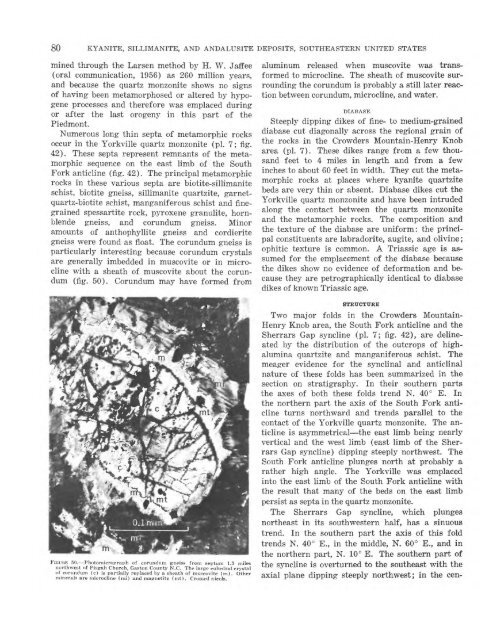Kyanite, Sillimanite, and Andalusite Deposits of the Southeastern ...
Kyanite, Sillimanite, and Andalusite Deposits of the Southeastern ...
Kyanite, Sillimanite, and Andalusite Deposits of the Southeastern ...
Create successful ePaper yourself
Turn your PDF publications into a flip-book with our unique Google optimized e-Paper software.
80 KYANITE, SILLIMANITE, AND ANDALUSITE DEPOSITS, SOUTHEASTERN UNITED STATES<br />
mined through <strong>the</strong> Larsen method by H. W. Jaffee<br />
(oral communication, 1956) as 260 million years,<br />
<strong>and</strong> because <strong>the</strong> quartz monzonite shows no signs<br />
<strong>of</strong> having- been metamorphosed or altered by hypogene<br />
processes <strong>and</strong> <strong>the</strong>refore was emplaced during<br />
or after <strong>the</strong> last orogeny in this part <strong>of</strong> <strong>the</strong><br />
Piedmont.<br />
Numerous long thin septa <strong>of</strong> metamorphic rocks<br />
occur in <strong>the</strong> Yorkville quartz monzonite (pi. 7; fig.<br />
42). These septa represent remnants <strong>of</strong> <strong>the</strong> metamorphic<br />
sequence on <strong>the</strong> east limb <strong>of</strong> <strong>the</strong> South<br />
Fork anticline (fig. 42). The principal metamorphic<br />
rocks in <strong>the</strong>se various septa are biotite-sillimanite<br />
schist, biotite gneiss, sillimanite quartzite, garnetquartz-biotite<br />
schist, manganiferous schist <strong>and</strong> finegrained<br />
spessartite rock, pyroxene granulite, hornblende<br />
gneiss, <strong>and</strong> corundum gneiss. Minor<br />
amounts <strong>of</strong> anthophyllite gneiss <strong>and</strong> cordierite<br />
gneiss were found as float. The corundum gneiss is<br />
particularly interesting because corundum crystals<br />
are generally imbedded in muscovite or in microcline<br />
with a sheath <strong>of</strong> muscovite about <strong>the</strong> corundum<br />
(fig. 50). Corundum may have formed from<br />
FIGUKE 50. Photomicrograph <strong>of</strong> corundum gneiss from septum 1.3 miles<br />
northwest <strong>of</strong> Pisgah Church, Gaston County N.C. The large euhedral crystal<br />
<strong>of</strong> corundum (c) is partially replaced by a sheath <strong>of</strong> muscovite (m). O<strong>the</strong>r<br />
minerals are microcline (mi) <strong>and</strong> magnetite (mt). Crossed nicols.<br />
aluminum released when muscovite was transformed<br />
to microcline. The sheath <strong>of</strong> muscovite surrounding<br />
<strong>the</strong> corundum is probably a still later reaction<br />
between corundum, microcline, <strong>and</strong> water.<br />
DIABASE<br />
Steeply dipping dikes <strong>of</strong> fine- to medium-grained<br />
diabase cut diagonally across <strong>the</strong> regional grain <strong>of</strong><br />
<strong>the</strong> rocks in <strong>the</strong> Crowders Mountain-Henry Knob<br />
area (pi. 7). These dikes range from a few thous<strong>and</strong><br />
feet to 4 miles in length <strong>and</strong> from a few<br />
inches to about 60 feet in width. They cut <strong>the</strong> metamorphic<br />
rocks at places where kyanite quartzite<br />
beds are very thin or absent. Diabase dikes cut <strong>the</strong><br />
Yorkville quartz monzonite <strong>and</strong> have been intruded<br />
along <strong>the</strong> contact between <strong>the</strong> quartz monzonite<br />
<strong>and</strong> <strong>the</strong> metamorphic rocks. The composition <strong>and</strong><br />
<strong>the</strong> texture <strong>of</strong> <strong>the</strong> diabase are uniform: <strong>the</strong> principal<br />
constituents are labradorite, augite, <strong>and</strong> olivine;<br />
ophitic texture is common. A Triassic age is assumed<br />
for <strong>the</strong> emplacement <strong>of</strong> <strong>the</strong> diabase because<br />
<strong>the</strong> dikes show no evidence <strong>of</strong> deformation <strong>and</strong> because<br />
<strong>the</strong>y are petrographically identical to diabase<br />
dikes <strong>of</strong> known Triassic age.<br />
STRUCTURE<br />
Two major folds in <strong>the</strong> Crowders Mountain-<br />
Henry Knob area, <strong>the</strong> South Fork anticline <strong>and</strong> <strong>the</strong><br />
Sherrars Gap syncline (pi. 7; fig. 42), are delineated<br />
by <strong>the</strong> distribution <strong>of</strong> <strong>the</strong> outcrops <strong>of</strong> highalumina<br />
quartzite <strong>and</strong> manganiferous schist. The<br />
meager evidence for <strong>the</strong> synclinal <strong>and</strong> anticlinal<br />
nature <strong>of</strong> <strong>the</strong>se folds has been summarized in <strong>the</strong><br />
section on stratigraphy. In <strong>the</strong>ir sou<strong>the</strong>rn parts<br />
<strong>the</strong> axes <strong>of</strong> both <strong>the</strong>se folds trend N. 40° E. In<br />
<strong>the</strong> nor<strong>the</strong>rn part <strong>the</strong> axis <strong>of</strong> <strong>the</strong> South Fork anticline<br />
turns northward <strong>and</strong> trends parallel to <strong>the</strong><br />
contact <strong>of</strong> <strong>the</strong> Yorkville quartz monzonite. The anticline<br />
is asymmetrical <strong>the</strong> east limb being nearly<br />
vertical <strong>and</strong> <strong>the</strong> west limb (east limb <strong>of</strong> <strong>the</strong> Sherrars<br />
Gap syncline) dipping steeply northwest. The<br />
South Fork anticline plunges north at probably a<br />
ra<strong>the</strong>r high angle. The Yorkville was emplaced<br />
into <strong>the</strong> east limb <strong>of</strong> <strong>the</strong> South Fork anticline with<br />
<strong>the</strong> result that many <strong>of</strong> <strong>the</strong> beds on <strong>the</strong> east limb<br />
persist as septa in <strong>the</strong> quartz monzonite.<br />
The Sherrars Gap syncline, which plunges<br />
nor<strong>the</strong>ast in its southwestern half, has a sinuous<br />
trend. In <strong>the</strong> sou<strong>the</strong>rn part <strong>the</strong> axis <strong>of</strong> this fold<br />
trends N. 40° E., in <strong>the</strong> middle, N. 60° E., <strong>and</strong> in<br />
<strong>the</strong> nor<strong>the</strong>rn part, N. 10° E. The sou<strong>the</strong>rn part <strong>of</strong><br />
<strong>the</strong> syncline is overturned to <strong>the</strong> sou<strong>the</strong>ast with <strong>the</strong><br />
axial plane dipping steeply northwest; in <strong>the</strong> cen-
















